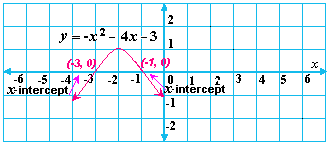Solved Examples and Worksheet for Finding Intercepts of Quadratic Functions
A. Two
B. Zero
C. One
D. Many
Step: 1
[Original equation.]
Step: 2
The x y
Step: 3
0 = -7x x
[Substitute 0 for y
Step: 4
Compare the equation with the standard form to get the values of a b c
Step: 5
[Substitute a b c
Step: 6
= -187
[Simplify.]
Step: 7
Since the discriminant is negative, the quadratic equation has no real solution.
Step: 8
So, the graph has no x-intercepts.
Correct Answer is : Zero
A. 3 and - 1
B. - 3 and 1
C. 3 and 1
D. - 3 and - 1
Step: 1
[Standard form of a quadratic equation.]
Step: 2
- x x
[Original equation.]
Step: 3
- x x
[Subtract 3 from each side.]
Step: 4
Sketch the graph of the related quadratic function y x x


Step: 5
In the graph shown, the x
Correct Answer is : - 3 and - 1
A. Two
B. One
C. Many
D. Zero
Step: 1
[Original equation.]
Step: 2
The x y
Step: 3
0 = - 3x x
[Replace y
Step: 4
Compare the equation with the standard form to get the values of a b c
Step: 5
[Substitute a b c
Step: 6
= -32
[Simplify.]
Step: 7
Since the discriminant is negative, the quadratic equation has no real solution.
Step: 8
So, the graph has no x
Correct Answer is : Zero
A. One
B. Many
C. Zero
D. Two
Step: 1
[Original equation.]
Step: 2
The x y
Step: 3
0 = - 6x x
[Replace y
Step: 4
Compare the equation with the standard form to get the values of a b c
Step: 5
[Substitute a b c
Step: 6
= -119
[Simplify.]
Step: 7
Since the discriminant is negative, the quadratic equation has no real solution.
Step: 8
So, the graph has no x
Correct Answer is : Zero
A. Zero
B. Many
C. Two
D. One
Step: 1
[Original equation.]
Step: 2
The x y
Step: 3
0 = x x
[Replace y
Step: 4
Compare the equation with the standard form to get the values of a b c
Step: 5
[Substitute a b c
Step: 6
= 16 - 16 = 0
[Simplify.]
Step: 7
Since the discriminant is equal to zero, the quadratic equation has only one solution.
Step: 8
So, the graph has one x
Correct Answer is : One
- Determining a given Relation is a Function-Algebra1-Solved Examples
- Finding Values of a Function for a given Domain-Algebra1-Solved Examples
- Graphing Linear Functions for a Given Domain-Algebra1-Solved Examples
- Graphing Linear Functions-Algebra1-Solved Examples
- Finding the Rate of Change-Algebra1-Solved Examples
- Finding Intercepts of a Linear Equation-Algebra1-Solved Examples
- Graphing Piecewise and Step Functions-Algebra1-Solved Examples
- Graphing Absolute Value Functions-Algebra1-Solved Examples
- Graphing and Analyzing Quadratic Functions-Algebra1-Solved Examples
- Identifying and Graphing Square Root Functions-Algebra1-Solved Examples
- Comparing Properties of Two Functions-Algebra1-Solved Examples
- Finding Intervals for Increasing and Decreasing Functions-Algebra1-Solved Examples
- Representing Exponential Functions Using Tables or Graphs-Algebra1-Solved Examples
- Graphing Logarithmic Functions-Algebra1-Solved Examples
- Graphing Trigonometric Functions-Algebra1-Solved Examples
- Identifying and Using Recursive Formula-Algebra1-Solved Examples
Related Worksheet
- Intercept